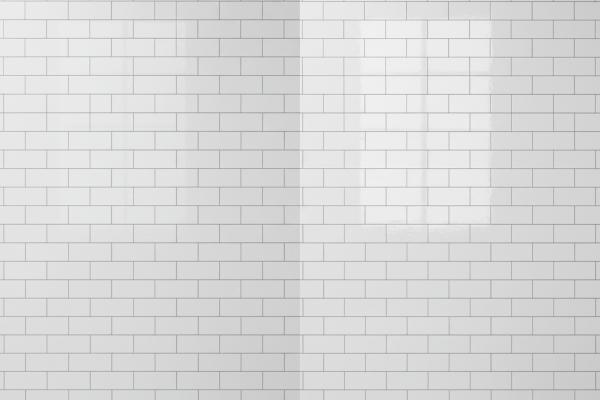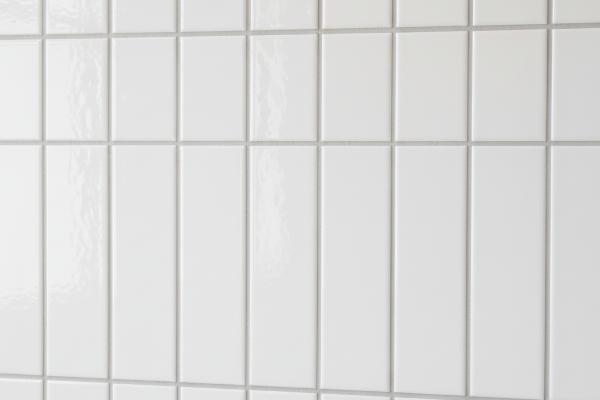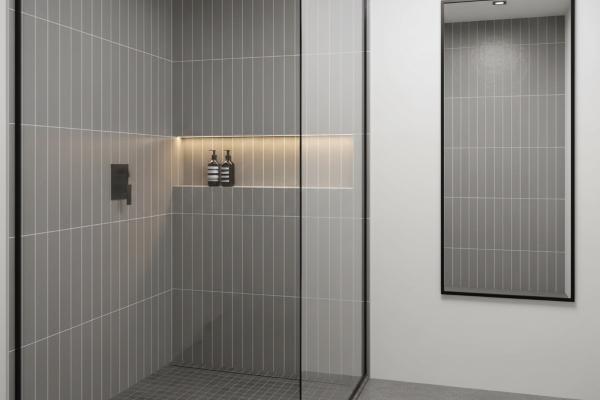Choosing between matte and glossy finishes for your subway tile project significantly impacts both aesthetics and daily maintenance. Matte subway tiles deliver a contemporary, understated elegance with superior slip resistance and minimal visible water spots, while glossy tiles create dramatic light reflection and a classic, easy-to-clean surface ideal for backsplashes. Your decision should balance style preferences, room function, and long-term upkeep requirements.
The finish you select changes how light interacts with your walls, influences perceived room size, and determines your cleaning routine for years ahead. Whether you're exploring herringbone subway tile backsplash patterns for a kitchen refresh or planning a complete bathroom renovation, understanding these two distinct finishes prevents costly mistakes and buyer's remorse.
This guide examines every practical consideration between matte and glossy subway tiles-from visual impact and cleaning demands to design versatility and installation nuances. You'll discover which finish complements specific lighting conditions, how each performs in wet environments, and exactly when to choose one over the other for functional results that match your lifestyle.
Light Behavior: How Each Finish Changes Your Room
Glossy subway tiles act as mirrors for natural and artificial light, bouncing illumination throughout kitchens and bathrooms to create brighter, more expansive spaces. This reflective quality amplifies small rooms, making cramped powder rooms feel larger and darker kitchens appear more welcoming. The linear 5x10 glossy 3D decorative subway tile demonstrates this effect beautifully, with its dimensional surface catching light from multiple angles.
Matte finishes absorb rather than reflect light, delivering a softer, more intimate atmosphere that reduces glare in sun-drenched spaces. According to industry research on ceramic tile markets, matte finishes have grown 47% in popularity over the past five years, particularly for west-facing kitchens where afternoon sun creates harsh reflections on glossy surfaces.
The choice becomes critical in rooms with specific lighting challenges. A basement bathroom with limited natural light benefits from glossy tiles that maximize every lumen, while a skylit shower stall performs better with matte tiles that won't create blinding glare during morning routines.
When Light Direction Matters
Consider your primary light sources before committing to a finish. Direct overhead lighting on gloss vertical subway tile creates hotspots and visual fatigue, while the same lighting on matte tiles distributes evenly across surfaces. Side-mounted sconces or under-cabinet lighting work beautifully with either finish, though glossy tiles will project that light deeper into the room.
The Maintenance Reality: Daily Cleaning Differences

Glossy tiles earned their kitchen backsplash reputation through genuinely superior stain resistance. The glass-like surface prevents oil, tomato sauce, and cooking splatters from penetrating, allowing quick wipe-downs with standard cleaners. According to cleaning experts specializing in porcelain tile, glossy finishes require 30% less scrubbing time than matte alternatives for the same level of cleanliness.
However, that same smooth surface showcases every water spot, soap streak, and fingerprint with unflattering clarity. Homeowners with hard water frequently find themselves battling visible mineral deposits that appear within hours of cleaning. The imagine 3x12 matte porcelain subway tile eliminates this frustration entirely-water spots simply vanish into the textured surface.
Matte tiles demand more elbow grease for deep stains since their slightly porous texture can trap debris in microscopic valleys. Yet they reward that extra effort by staying visually clean between deep cleans, hiding everyday splashes and fingerprints that would scream for attention on glossy alternatives. For busy households where daily buffing isn't realistic, matte finishes maintain that "just cleaned" appearance longer.
Grout Line Considerations
Your finish choice affects grout maintenance too. Subway tile with dark grout alongside glossy tiles creates sharp contrast that emphasizes any grout discoloration, while matte tiles soften that contrast and camouflage minor grout aging. This subtle difference impacts how frequently you'll need professional grout cleaning or re-sealing.
What Subway Tiles Finish Fits Your Design Vision?

Modern Minimalist Kitchens: Matte white or gray chevron subway tile creates the clean lines and soft shadows that define contemporary design. The lack of shine prevents visual competition with statement lighting fixtures or high-gloss cabinetry.
Traditional & Transitional Spaces: Glossy subway tiles in classic ceramic materials honor the format's historic roots. Their reflective quality mimics the hand-glazed tiles found in early 1900s New York subway stations, delivering authentic period charm that matte versions can't replicate.
Farmhouse & Rustic Interiors: Matte finishes in cream or beige tones complement natural wood, stone countertops, and vintage fixtures without introducing jarring reflective elements. The subtle texture adds tactile interest that aligns with farmhouse design's handmade aesthetic.
Bold & Eclectic Designs: Glossy colored subway tile in jewel tones or vibrant hues delivers maximum color saturation and dramatic impact. That same deep blue or emerald green in a matte finish appears muted and subdued-beautiful, but serving different design intentions.
According to 2025 kitchen trend forecasts, mixed-finish applications are gaining traction. Designers pair glossy subway tiles on backsplashes with matte floor tiles or combine glossy white with matte colored accents in basketweave subway tile patterns for dimensional interest.
Comparing Key Performance Factors
Feature | Glossy Subway Tiles | Matte Subway Tiles |
Light Reflection | High reflection, brightens spaces | Low reflection, reduces glare |
Stain Resistance | Excellent, non-porous surface | Good, but requires more scrubbing |
Water Spot Visibility | Highly visible, requires frequent buffing | Minimal visibility, forgiving |
Slip Resistance (Floors) | Lower coefficient of friction | Higher slip resistance |
Design Style | Traditional, glamorous, bold | Contemporary, understated, soft |
Color Depth | Vibrant, saturated appearance | Subtle, muted tones |
Fingerprint Visibility | Very noticeable | Barely visible |
Price Range | Typically $3-15 per sq ft | Typically $4-18 per sq ft |
Installation Difficulty | Standard application | Standard application |
Resale Appeal | Broad market appeal | Design-savvy buyers |
Pros and Cons: Making the Final Decision

Glossy Subway Tile Advantages
- Reflects light to brighten dim spaces
- Easier initial stain removal and cleaning
- Classic aesthetic with timeless appeal
- More vibrant color presentation
- Better suited for creative backsplash ideas
- Widely available in various sizes at most local showrooms
Glossy Subway Tile Disadvantages
- Creates glare in brightly lit rooms
- Shows water spots and streaks immediately
- Requires frequent buffing and maintenance
- Slippery When Wet
- Fingerprints and smudges highly visible
- Can feel dated in ultra-modern designs
Matte Subway Tile Advantages
- Hides water spots and everyday mess
- Reduces glare in sunny exposures
- Contemporary aesthetic that feels current
- Better slip resistance for floor applications
- Fingerprints virtually invisible
- Creates sophisticated, spa-like ambiance
Matte Subway Tile Disadvantages
- Requires more scrubbing for set-in stains
- Doesn't brighten spaces
- Limited color vibrancy compared to glossy
- Can feel too casual for formal designs
- More Porous Surface
- Slightly higher price point for premium options
Your 5-Step Finish Selection Process
Step 1: Evaluate Your Lighting Conditions Stand in the space at different times of day and note where natural light enters, how artificial lighting performs, and whether glare already causes problems. Rooms with abundant natural light benefit from matte's glare reduction, while dimly lit spaces need glossy reflective boost.
Step 2: Assess Your Cleaning Commitment Honestly evaluate your cleaning frequency and tolerance for visible mess. If you clean daily and prefer that "just detailed" sparkle, glossy tiles reward that effort. If you clean thoroughly but less frequently, matte finishes disguise the interim periods better.
Step 3: Define Your Design Direction Review inspiration photos from sources like House Beautiful bathroom remodels and identify which finish appears most frequently in designs you love. Your instinctive preference usually aligns with your personal style.
Step 4: Consider Long-Term Functionality Think beyond initial installation to five years down the line. Will you still want to buff water spots daily? Will the contemporary matte trend feel dated when you eventually sell? Consider both present needs and future flexibility when choosing between porcelain options available in both finishes.
Step 5: Request Physical Samples Digital photos deceive-glossy tiles photograph darker than they appear in person, while matte tiles often look lighter. Order samples from reputable suppliers and view them in your actual space under your specific lighting before purchasing full quantities. The difference between computer screens and reality can be substantial.
Room-Specific Recommendations for Real Homes
The Working Kitchen:
If your kitchen sees serious cooking with splattering oils and bubbling sauces, glossy subway tile kitchen ideas behind the range deliver the easiest cleanup. Balance this with matte tiles in adjacent areas for visual interest without sacrificing function where it matters most.
The Master Bathroom:
Matte tiles excel in primary bathrooms where you want spa-like serenity over dramatic flair. The soft, non-reflective quality creates a calm retreat, while the reduced water spot visibility means your bathroom looks clean even when it technically needs attention. Explore the perfection 2.5x8 matte porcelain subway tile for this application.
The Powder Room:
Go bold with glossy tiles in small guest bathrooms where you can showcase dramatic modern subway tile patterns without committing to the maintenance across larger square footage. The reflective quality makes these compact spaces feel more generous.
The Basement Bathroom:
Glossy tiles become functional necessities in below-grade bathrooms where natural light doesn't reach. The light-bouncing properties compensate for the inherent darkness, creating a space that feels less dungeon-like and more welcoming.
According to tile installation specialists, proper substrate preparation matters more than finish selection for long-term performance. Whether you choose matte or glossy, ensure your installer follows manufacturer specifications for substrate flatness and waterproofing.

The Mixed-Finish Strategy: Best of Both Worlds
Progressive designers increasingly specify both finishes within a single space, leveraging each material's strengths strategically. A common approach pairs glossy backsplash tiles for easy cooking cleanup with matte shower tiles that won't show water spots. Another popular combination uses glossy accent tiles in basketweave subway tile patterns against a matte field tile background.
This approach requires careful planning to avoid a disjointed appearance. Maintain consistent color families across both finishes, use one finish as the clear dominant material (70-80% of coverage), and let the secondary finish serve a specific functional purpose rather than random placement.
Understanding the differences between porcelain vs ceramic tiles adds another layer to this decision, as finish interacts differently with each material base. Porcelain typically offers more durable glossy finishes that resist scratching, while ceramic delivers richer color depth in matte applications.
Material Matters: How Tile Composition Affects Finish Performance
The history and composition of tiles directly impacts how each finish performs over time. Porcelain tiles maintain their glossy finish longer due to superior density and scratch resistance, while ceramic tiles may show wear patterns more quickly in high-traffic applications. This becomes relevant when comparing finish durability across different price points.
When working with professional installers, discuss how proper grouting techniques vary slightly between finishes. Glossy tiles allow easier grout haze removal since cleaners won't dull an already matte surface, but any scratches from aggressive cleaning show more prominently on that reflective surface.
Moving Forward: Making Your Selection
Your lifestyle drives this decision more than design trends or resale considerations. A household with young children benefits from matte's forgiving nature, hiding sticky fingerprints and splash marks that glossy tiles broadcast loudly. Conversely, empty nesters who enjoy pristine homes and have time for regular maintenance may prefer glossy tiles' sparkling clarity and easy wipe-down convenience.
Visit our showroom to experience both finishes under various lighting conditions and see completed installations that showcase each option's real-world appearance. Bring photos of your space, samples of your cabinet finishes or paint colors, and questions about your specific application. Our design team evaluates your lighting, cleaning habits, and style preferences to recommend the finish that serves your needs best.
The subway tile bathroom trends currently favor matte finishes, but your individual space may demand glossy's practical advantages. Trust your instincts after proper research-the right finish becomes obvious once you understand how each performs in your specific circumstances.
Frequently Asked Questions
Can I use matte subway tiles on kitchen backsplashes?
Yes, matte subway tiles work beautifully on kitchen backsplashes and offer excellent everyday maintenance with their ability to hide water spots and light splashes. However, they require more scrubbing effort for heavy cooking stains like baked-on grease compared to glossy alternatives. Many homeowners choose matte tiles throughout except directly behind the cooktop, where they install glossy tiles for easier heavy-duty cleaning.
Do glossy subway tiles make small bathrooms look bigger?
Glossy subway tiles do create the illusion of more space by reflecting light and visually pushing walls outward. This effect works best in bathrooms with good lighting, as the reflective quality amplifies available light. However, in very small bathrooms with limited lighting, the reflection can sometimes create an overwhelming, busy appearance rather than a spacious feel.
Which finish is better for shower walls?
Matte finishes generally perform better for shower walls because they hide water spots, soap scum, and mineral deposits that appear immediately on glossy tiles in wet environments. The improved slip resistance of matte tiles also makes them safer if you're considering the same tile for shower floors. However, if you clean your shower daily and prefer a bright, reflective surface, glossy tiles remain a valid choice.
Are matte tiles harder to clean than glossy tiles?
Matte tiles require more scrubbing effort to remove set-in stains because their slightly textured surface can trap debris in microscopic valleys. However, for everyday maintenance, matte tiles actually appear cleaner longer since they don't show water spots, fingerprints, or streaks like glossy tiles do. The trade-off is less frequent visible mess versus more effort when deep cleaning is needed.
Can I mix matte and glossy subway tiles in the same room?
Yes, mixing matte and glossy finishes creates visual interest and leverages each finish's functional strengths. The key is maintaining consistent color tones and using one finish as the dominant material (70-80% coverage) while the other serves as an accent. Popular combinations include glossy backsplashes with matte wall tiles, or matte field tiles with glossy decorative inserts in herringbone or chevron patterns.
